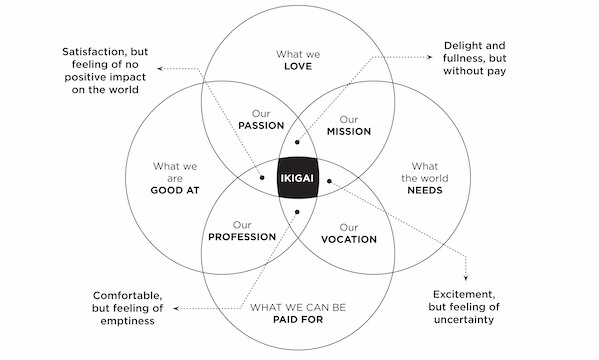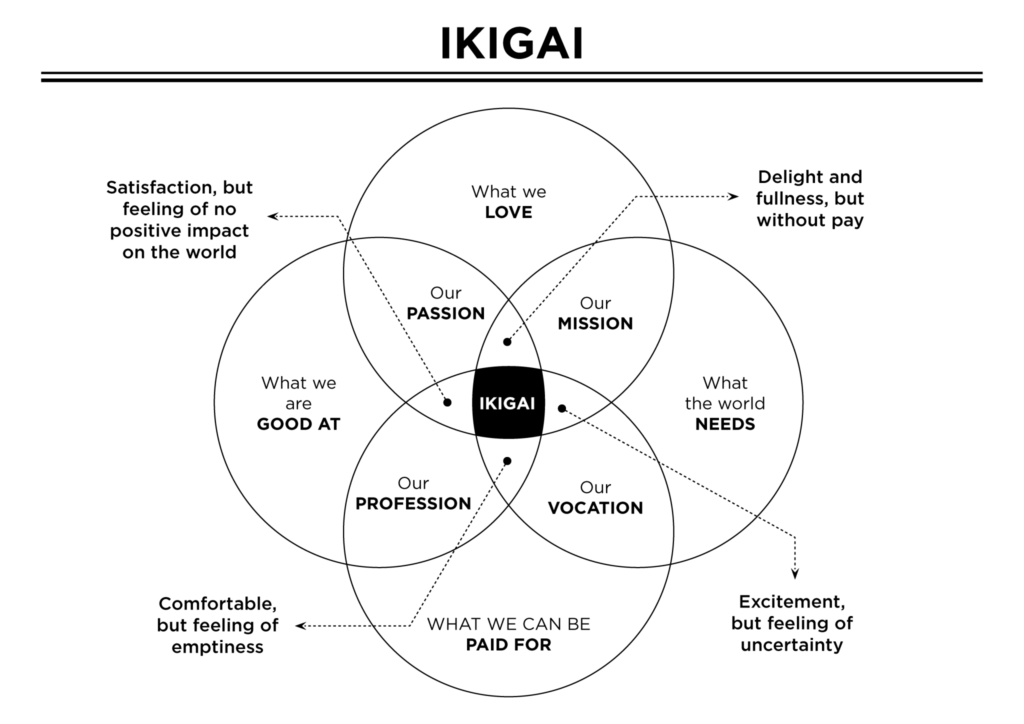Ikigai is a Japanese concept which roughly translates as ‘the happiness of always being busy’. Japan is the country where people live the longest in the world and ikigai seems to be one of the reasons why this is so. Ikigai coaching is something I offer and below I take you through this.
Ikigai and finding your purpose
Psychologist Mihaly Csikzentmihalyi called the state of pleasure, delight, creativity and process when we are completely immersed in life – ‘flow’. This is also one key ingredient of ikigai. To achieve this, we need to increase the time we spend on activities that bring us this ‘flow’. When we are in flow we concentrate on the task at hand without any distractions.
If you focus on thinking about the activities in your life that give you flow – you could write them down and ask yourself what they have in common e.g. Are they activities that you do with people or when you are by yourself? Are they activities that you do when you move your body, or are they ones where you are just thinking? Also, are they activities that you can be paid for?
Also, you can try new things that might be similar to what’s on your list.
Below you will see the ikigai diagram that shows how you can find your place in life, in a very practical way:
The ten rules of ikigai
Ikigai is much more than this diagram. Here is a summary (from ‘Ikigai, the Japanese secret to a long and happy life’ by Hector Garcia and Francesc Miralles):
- Stay active, don’t retire
- Take it slow
- Don’t fill your stomach
- Surround yourself with good friends
- Get in shape
- Smile
- Reconnect with nature
- Give thanks
- Live in the moment
- Follow your purpose – make your mission to find out what this is.
Two Westerners brought this ikigai diagram to the fore. Andrés Zuzunaga created the initial diagram without ‘ikigai’ written in the middle and Marc Winn added this in and blogged about it. Ikigai can be a useful concept for career coaching.
Another translation of ikigai is ‘Life’s purpose’ and the venn diagram nicely captures the sweet spot where purpose can be found. I have recently read Tim Tamashiro’s book* on ‘How to Ikigai’. This goes into the practicalities of what this diagram means. It is a nice, useable, thoughtful book, which I thoroughly recommend.
Coaching yourself to find your half ikigai
The Tamahsiro book takes you through your ‘half ikigai’. This is where you focus and start to notice where two of the circles in the venn diagram meet. These are ‘what you love to do’ and ‘what you are good at’.
Here are some tips for this:
- Focus your free time on doing what brings you joy, be mindful of what these tasks are. This could be music, art, playing sports, crafting or making items, writing, volunteering to help people etc.
- Once you have a reasonable list of what these are, sort out which of these come easily to you.
- See then if you can spend more time on these areas, building up your skills and expertise. Can you think of a side hustle where you get even more practice at these skills and can maybe even earn a bit of money from this? Examples could be playing in a band, blogging about art or sports, making items and selling them, writing articles and getting paid for them. Do not worry too much at this stage if you are not earning money, for example you could be doing a course to get better in this area. If you do this then you have a half ikigai, which is a great achievement, as you will be spending more time enjoying yourself and improving your skills.
- Also, think about where else you could implement your half ikigai. Could you do some ‘job crafting’ in your current role, so that you do more of work you find enjoyable? Job crafting means tweaking what you do day-to-day in your work. Coaching yourself or getting your boss on board with your half ikigai will be key here.
- Other recommendations in the book are to learn to be more mindful, to meditate and even to take time off in order to focus on finding your ikigai. Tamashiro calls this an ‘ikigap year’, where you focus on your half ikigai and see where this can take you.
Your full ikigai
When you are working out your full ikigai (and everyone has one), you want to start to define your life’s purpose. It will be an action word such as ‘to create’, ‘to delight’, ‘to make a difference’, ‘to heal’, ‘to teach’ etc. The idea is that once you have found the exact action word, then when you implement it, you’ll have found your life’s purpose. This therefore provides a model for a long and fulfilling life.
Your full ikigai is where you bring in the other two circles of the venn diagram, the ‘what the world needs’ and the ‘what you can be rewarded for’. This for me is the bit that can be tricky and I don’t think everyone can slip easily from a half to full ikigai. Though this would be the goal.
I think that focusing on your half ikigai, and changing up some areas of your life, can be something to which you can aspire. It could be possible to move towards implementing your full ikigai. At least you should have a bit of a clearer idea of what your life’s purpose is, if you follow the steps! Coaching using the concepts of ikigai is something I can offer, so if you are interested in this let me know.
You might also like the blog I’ve written on Ikigai and higher life expectancy.


